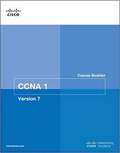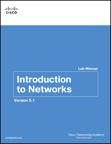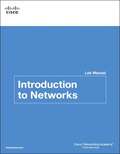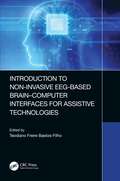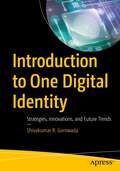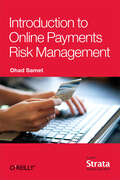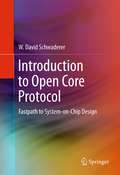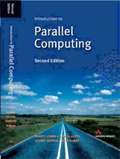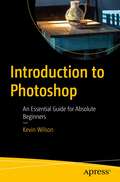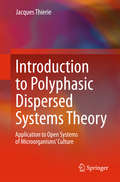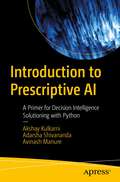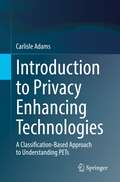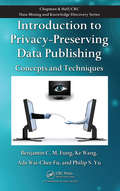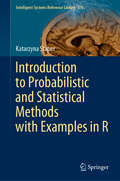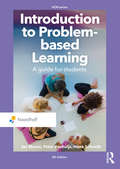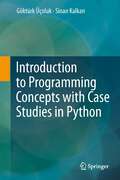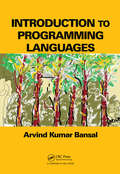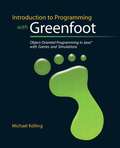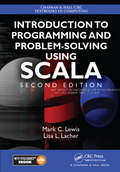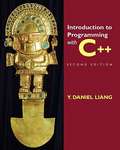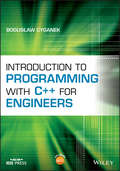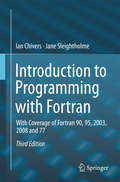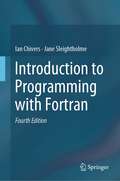- Table View
- List View
Introduction to Networks Course Booklet (CCNA)
by Cisco Networking AcademyYour Cisco Networking Academy® Course Booklet is designed as a study resource you can easily read, highlight, and review on the go, wherever the Internet is not available or practical: The text is extracted directly, word-for-word, from the online course so you can highlight important points and take notes in the “Your Chapter Notes” section. Headings with the exact page correlations provide a quick reference to the online course for your classroom discussions and exam preparation. An icon system directs you to the online curriculum to take full advantage of the images embedded within the Networking Academy online course interface and reminds you to do the labs, interactive activities, packet tracer activities, watch videos, and take the chapter quizzes. <p><p> The Course Booklet is a basic, economical paper-based resource to help you succeed with the Cisco Networking Academy online course. <p><p> This book is offered exclusively for students enrolled in Cisco Networking Academy courses. It is not designed for independent study or professional certification preparation. Visit netacad.com to learn more about program options and requirements.
Introduction to Networks Lab Manual, Version 5.1
by Cisco Networking AcademyThis manual provides students enrolled in a Cisco Networking Academy Introduction to Networks course with a convenient, complete collection of all the course lab exercises that provide hands-on practice and challenges.
Introduction to Networks: Lab Manual, v5.0
by Cisco Networking Academy Program StaffThe Introduction to Networks Lab Manual provides students enrolled in a Cisco Networking Academy Introduction to Networks course with a convenient, complete collection of all the course lab exercises that provide hands-on practice and challenges.
Introduction to Non-Invasive EEG-Based Brain-Computer Interfaces for Assistive Technologies
by Teodiano Freire Bastos-FilhoThis book aims to bring to the reader an overview of different applications of brain-computer interfaces (BCIs) based on more than 20 years of experience working on these interfaces. The author provides a review of the human brain and EEG signals, describing the human brain, anatomically and physiologically, with the objective of showing some of the patterns of EEG (electroencephalogram) signals used to control BCIs. It then introduces BCIs and different applications, such as a BCI based on ERD/ERS Patterns in α rhythms (used to command a robotic wheelchair with an augmentative and alternative communication (AAC) system onboard it); a BCI based on dependent-SSVEP to command the same robotic wheelchair; a BCI based on SSVEP to command a telepresence robot and its onboard AAC system; a BCI based on SSVEP to command an autonomous car; a BCI based on independent-SSVEP (using Depth-of-Field) to command the same robotic wheelchair; the use of compressive technique in SSVEP-based BCI; a BCI based on motor imagery (using different techniques) to command a robotic monocycle and a robotic exoskeleton; and the first steps to build a neurorehabilitation system based on motor imagery of pedalling together an in immersive virtual environment. This book is intended for researchers, professionals and students working on assistive technology.
Introduction to One Digital Identity: Strategies, Innovations, and Future Trends
by Shivakumar R. GoniwadaExplore the dynamics of digital identity, a crucial component in today’s modern technology-driven era. This engaging book offers a deep understanding of how digital identity is evolving rapidly, why it’s so significant, and offers organizations, regulatory bodies, and academicians the strategies needed to adopt secure decentralized digital identity features effectively. It’s a must-read for those aiming to grasp the intricacies of digital identity and leverage it for future innovation and security.The book begins by redefining digital identity, examining its evolution and the profound impact it has on both individuals and organizations. It then delves into the development of digital identity strategies, laying the foundation for future digital transformations. Covering a wide range of topics, the book discusses the innovation, challenges, and technological exploration in digital identity. A special focus is given to biometric technologies and the implementation of decentralized digital identities, addressing critical areas such as identity governance, blockchain, AI and advanced biometrics. The book also investigates the implications of digital identity across various industries, including cross border travel, healthcare, social media, finance, metaverse, IoT etc. finally the book provides not only emerging trends but offers a glimpse into the future digital identity. Whether you’re a tech professional, business leader, student or simply keen on understanding the impact of digital advancements, this book promises to offer insightful perspectives and practical solutions for navigating the complex world of digital identity. It underscores the importance of identity in spearheading digital innovation, making it a key resource for anyone looking to stay ahead in the digital landscape. As you reach its conclusion, you’ll be equipped with a wealth of knowledge and insights that are crucial in today’s digital era.What You'll LearnDigital identity strategies and their role in shaping the future of digital identityDifferent facets of digital identitySpecifics of biometric technologies and decentralized digital identity Industry specific digital identity and its implementationCrucial aspects of privacy, ethics, and secure in the context of digital identityWho This Book Is ForSoftware professionals, security practitioners, architects, senior managers, executives, and students who are interested in digital identity.
Introduction to Online Payments Risk Management
by Ohad SametIf you've been tasked with building a team to handle risk management for online payments (RMP), this practical introduction provides a framework for choosing the technologies and personnel you need. Author and financial services executive Ohad Samet explains the components of payments risk management, and presents a coherent strategy and operational approach.You'll learn the answers to questions you're likely to encounter in the first 18 months of operation, with information that Samet has shaped and tested over several years in the industry. This book is ideal whether you intend to be a one-person task force or work with dozens of agents and analysts.Use both a portfolio and behavioral approach to analyzing and optimizing lossesLearn about your customers to determine if they can and will meet obligationsBuild an RMP team for payment risk operations, analytics, and decision automationUse linking mechanisms and velocity models to detect unusual activity among your customersDesign system and data architecture to facilitate your activity analysisImplement the decision and loss-reduction mechanisms you need to act on your findings
Introduction to Open Core Protocol
by W David SchwadererThis book introduces Open Core Protocol (OCP) not as a conventional hardware communications protocol but as a meta-protocol: a means for describing and capturing the communications requirements of an IP core, and mapping them to a specific set of signals with known semantics. Readers will learn the capabilities of OCP as a semiconductor hardware interface specification that allows different System-On-Chip (SoC) cores to communicate. The OCP methodology presented enables intellectual property designers to design core interfaces in standard ways. This facilitates reusing OCP-compliant cores across multiple SoC designs which, in turn, drastically reduces design times, support costs, and overall cost for electronics/SoCs.
Introduction to Parallel Computing (Second Edition)
by Ananth Grama George Karypis Vipin Kumar Anshul GuptaIntroducation to Parallel Computing is a complete end-to-end source of information on almost all aspects of parallel computing from introduction to architectures to programming paradigms to algorithms to programming standards. It covers traditional Computer Science algorithms, scientific computing algorithms, and data intensive algorithms.
Introduction to Photography: A Visual Guide to the Essential Skills of Photography and Lightroom
by Mark GalerThis book is intended to be the primary textbook to support any college who would like to run a Photography 101 course for students. The course is designed to offer tutors an independent learning tool to enable students to learn the craft of using an interchangeable lens camera (DSLR or Mirrorless) and the basics of an image-editing program (Adobe Lightroom) to enable them to take creative control of the imaging process. The curriculum offers a step-by-step and jargon-free approach to learning the fundamental skills of creative camera control. Each page features a large image with a brief explanation of how the creative controls of the camera have led to the resulting visual appearance of the image. Information on each page is stripped down the essentials and text is carefully selected to be unambiguous and kept to the bare minimum to ensure rapid acquisition of the skills on offer. This effective course-in-a-book allows students quickly to become technically proficient, and instructors to efficiently evaluate students' progress.
Introduction to Photoshop: An Essential Guide for Absolute Beginners
by Kevin WilsonThis full-color book is an essential guide to getting started with Adobe Photoshop. It's packed with tutorials, illustrations, and practical exercises to help you make sense of this complex and powerful software.You'll start with the basics of Photoshop, including an overview of its myriad tools and other options. Next, you will learn about some of the common tasks that can be performed in Photoshop, such as how to touch up images and basic applications in photography. You'll also be walked through how to leverage Photoshop for special and 3D effects. Each and every technique author Kevin Wilson presents is illustrated step-by-step using screenshots with concise, easy to follow text. Downloadable sample photoshop files and images are also provided, to help you work your way through the book.Whether you are a graphic design student, a photographer, or just a keen computer user, this book will provide you with a firm grasp of the underpinning foundations of Photoshop and equip you with the skills needed to unleash its full power.What You Will LearnUnderstand Photoshop's many toolsUse Photoshop to execute common image manipulation tasks Touch up photographs and other images in PhotoshopRemove lens distortion and make photos look more professionalWho This Book Is ForStudents, those interested in starting graphic design, and photographers looking to enhance, clean up and manipulate their photos. No experience with image-manipulation software is needed.
Introduction to Polarization Physics
by Sandibek B. Nurushev Mikhail F. Runtso Mikhail N. StrikhanovThis book is devoted to the polarization (spin) physics of high energy particles and contains three parts. The first part presents the theoretical prefaces of polarization in the particle physics for interpretations, predictions and bases for understanding the following two parts. The second part of the book presents the description of the essential polarization experiments including the recent ones. This part is devoted to the innovative instrumentations, gives the parameters of the polarized beams, targets, polarized gas jets and polarimeters. The third part of the book concentrates on the important achievements in polarization physics. The book can be used in lectures on nuclear and particle physics and and nuclear instruments and methods. As supplementary reading this book is useful for researchers working in particle and nuclear physics.
Introduction to Polyphasic Dispersed Systems Theory
by Jacques ThierieThis book introduces a new paradigm in system description and modelling. The author shows the theoretical and practical successes of his approach, which involves replacing a traditional uniform description with a polyphasic description. This change of perspective reveals new fluxes that are cryptic in the classical description. Several case studies are given in this book, which is of interest of those working with biotechnology and green chemistry.
Introduction to Prescriptive AI: A Primer for Decision Intelligence Solutioning with Python
by Akshay Kulkarni Adarsha Shivananda Avinash ManureGain a working knowledge of prescriptive AI, its history, and its current and future trends. This book will help you evaluate different AI-driven predictive analytics techniques and help you incorporate decision intelligence into your business workflow through real-world examples.The book kicks off with an introduction to decision intelligence and provides insight into prescriptive AI and how it can be woven into various business strategies and frameworks. You'll then be introduced to different decision intelligence methodologies and how to implement them, along with advantages and limitations of each. Digging deeper, the authors then walk you through how to perform simulations and interpret the results. A full chapter is devoted to embedding decision intelligence processes and outcomes into your business workflow using various applications. The book concludes by exploring different cognitive biases humans are prone to, and how those biases can be eliminated by combining machine and human intelligence.Upon completing this book, you will understand prescriptive AI, tools, and techniques and will be ready to incorporate them into your business workflow.What You Will LearnImplement full-fledged decision intelligence applications using PythonLeverage the tools, techniques, and methodologies for prescriptive AIUnderstand how prescriptive AI can be used in different domains through practical examplesInterpret results and integrate them into your decision makingWho This Book Is ForData Scientists and Machine Learning Engineers, as well as business professionals who want to understand how AI-driven decision intelligence can help grow their business.
Introduction to Privacy Enhancing Technologies: A Classification-Based Approach to Understanding PETs
by Carlisle AdamsThis textbook provides a unique lens through which the myriad of existing Privacy Enhancing Technologies (PETs) can be easily comprehended and appreciated. It answers key privacy-centered questions with clear and detailed explanations.Why is privacy important? How and why is your privacy being eroded and what risks can this pose for you? What are some tools for protecting your privacy in online environments? How can these tools be understood, compared, and evaluated? What steps can you take to gain more control over your personal data?This book addresses the above questions by focusing on three fundamental elements:It introduces a simple classification of PETs that allows their similarities and differences to be highlighted and analyzed;It describes several specific PETs in each class, including both foundational technologies and important recent additions to the field;It explains how to use this classification to determine which privacy goals are actually achievable in a given real-world environment. Once the goals are known, this allows the most appropriate PETs to be selected in order to add the desired privacy protection to the target environment. To illustrate, the book examines the use of PETs in conjunction with various security technologies, with the legal infrastructure, and with communication and computing technologies such as Software Defined Networking (SDN) and Machine Learning (ML).Designed as an introductory textbook on PETs, this book is essential reading for graduate-level students in computer science and related fields, prospective PETs researchers, privacy advocates, and anyone interested in technologies to protect privacy in online environments.
Introduction to Privacy-Preserving Data Publishing: Concepts and Techniques
by Philip S. Yu Benjamin C.M. Fung Ke Wang Ada Wai-Chee FuGaining access to high-quality data is a vital necessity in knowledge-based decision making. But data in its raw form often contains sensitive information about individuals. Providing solutions to this problem, the methods and tools of privacy-preserving data publishing enable the publication of useful information while protecting data privacy. Int
Introduction to Probabilistic and Statistical Methods with Examples in R (Intelligent Systems Reference Library #176)
by Katarzyna StaporThis book strikes a healthy balance between theory and applications, ensuring that it doesn’t offer a set of tools with no mathematical roots. It is intended as a comprehensive and largely self-contained introduction to probability and statistics for university students from various faculties, with accompanying implementations of some rudimentary statistical techniques in the language R. The content is divided into three basic parts: the first includes elements of probability theory, the second introduces readers to the basics of descriptive and inferential statistics (estimation, hypothesis testing), and the third presents the elements of correlation and linear regression analysis. Thanks to examples showing how to approach real-world problems using statistics, readers will acquire stronger analytical thinking skills, which are essential for analysts and data scientists alike.
Introduction to Problem-Based Learning (Routledge-Noordhoff International Editions)
by Henk Schmidt Jos Moust Peter BouhuijsIntroduction to Problem-based Learning teaches students how to work with the problem-based learning method, which requires mainly self-directed learning. Particular attention is given to the necessary skills to apply this method effectively. Why Introduction to Problem-based Llearning? • comprehensible introduction in the problem-based learning method • enables students to experience the full potential of this concept • discusses the use of digital devices Introduction to Problem-based learning provides students with the necessary skills to operate within as well as outside problem-based groups. It discusses issues like: How do you take on a problem? How do you collaborate with others? How do you deal with cultural diversity? How do you lead a tutorial group? How can you organize your studies best? Special attention is given to the use of computers, tablets and internet in a problem-based environment.
Introduction to Programming Concepts with Case Studies in Python
by Göktürk Üçoluk Sinan KalkanThe current text provides a clear introduction to Computer Science concepts in a programming environment. It is designed as suitable use in freshman- or introductory level coursework in CS and provides the fundamental concepts as well as abstract theorems for solving computational problems. The Python language serves as a medium for illustrating and demonstrating the concepts.
Introduction to Programming Languages
by Arvind Kumar BansalIn programming courses, using the different syntax of multiple languages, such as C++, Java, PHP, and Python, for the same abstraction often confuses students new to computer science. Introduction to Programming Languages separates programming language concepts from the restraints of multiple language syntax by discussing the concepts at an abstrac
Introduction to Programming With Greenfoot: Object-Oriented Programming in Java With Games and Simulations
by Michael KöllingIntroduction to Programming with Greenfoot: Object-Oriented Programming in Java with games and Simulations is ideal for introductory courses in Java Programming or Introduction to Computer Science. The only textbook to teach Java programming using Greenfoot--this is "Serious Fun. " Programming doesn't have to be dry and boring. This book teaches Java programming in an interactive and engaging way that is technically relevant, pedagogically sound, and highly motivational for students. Using the Greenfoot environment, and an extensive collection of compelling example projects, students are given a unique, graphical framework in which to learn programming.
Introduction to Programming and Problem-Solving Using Scala (Chapman & Hall/CRC Textbooks in Computing)
by Mark C. Lewis Lisa LacherPraise for the first edition: "The well-written, comprehensive book…[is] aiming to become a de facto reference for the language and its features and capabilities. The pace is appropriate for beginners; programming concepts are introduced progressively through a range of examples and then used as tools for building applications in various domains, including sophisticated data structures and algorithms…Highly recommended. Students of all levels, faculty, and professionals/practitioners.—D. Papamichail, University of Miami in CHOICE Magazine Mark Lewis’ Introduction to the Art of Programming Using Scala was the first textbook to use Scala for introductory CS courses. Fully revised and expanded, the new edition of this popular text has been divided into two books. Introduction to Programming and Problem-Solving Using Scala is designed to be used in first semester college classrooms to teach students beginning programming with Scala. The book focuses on the key topics students need to know in an introductory course, while also highlighting the features that make Scala a great programming language to learn. The book is filled with end-of-chapter projects and exercises, and the authors have also posted a number of different supplements on the book website. Video lectures for each chapter in the book are also available on YouTube. The videos show construction of code from the ground up and this type of "live coding" is invaluable for learning to program, as it allows students into the mind of a more experienced programmer, where they can see the thought processes associated with the development of the code. About the Authors Mark Lewis is a Professor at Trinity University. He teaches a number of different courses, spanning from first semester introductory courses to advanced seminars. His research interests included simulations and modeling, programming languages, and numerical modeling of rings around planets with nearby moons. Lisa Lacher is an Assistant Professor at the University of Houston, Clear Lake with over 25 years of professional software development experience. She teaches a number of different courses spanning from first semester introductory courses to graduate level courses. Her research interests include Computer Science Education, Agile Software Development, Human Computer Interaction and Usability Engineering, as well as Measurement and Empirical Software Engineering.
Introduction to Programming with C++ (2nd edition)
by Y. Daniel LiangA solid introduction to problem solving and programming using C++, the topics include: Introduction to Computers, Programs, and C++; Elementary Programming; Selections; Loops; Function Basics; Advanced Function Features; Single-Dimensional Arrays; Multidimensional Arrays; Objects and Classes; Class Design; Pointers and Dynamic Memory Management; Templates and Vectors; File I/O; Operator Overloading; Inheritance and Polymorphism; Exception Handling; Recursion; Algorithm Efficiency; Sorting, etc.
Introduction to Programming with C++ for Engineers (Wiley - IEEE)
by Boguslaw CyganekA complete textbook and reference for engineers to learn the fundamentals of computer programming with modern C++ Introduction to Programming with C++ for Engineers is an original presentation teaching the fundamentals of computer programming and modern C++ to engineers and engineering students. Professor Cyganek, a highly regarded expert in his field, walks users through basics of data structures and algorithms with the help of a core subset of C++ and the Standard Library, progressing to the object-oriented domain and advanced C++ features, computer arithmetic, memory management and essentials of parallel programming, showing with real world examples how to complete tasks. He also guides users through the software development process, good programming practices, not shunning from explaining low-level features and the programming tools. Being a textbook, with the summarizing tables and diagrams the book becomes a highly useful reference for C++ programmers at all levels. Introduction to Programming with C++ for Engineers teaches how to program by: Guiding users from simple techniques with modern C++ and the Standard Library, to more advanced object-oriented design methods and language features Providing meaningful examples that facilitate understanding of the programming techniques and the C++ language constructions Fostering good programming practices which create better professional programmers Minimizing text descriptions, opting instead for comprehensive figures, tables, diagrams, and other explanatory material Granting access to a complementary website that contains example code and useful links to resources that further improve the reader’s coding ability Including test and exam question for the reader’s review at the end of each chapter Engineering students, students of other sciences who rely on computer programming, and professionals in various fields will find this book invaluable when learning to program with C++.
Introduction to Programming with Fortran
by Jane Sleightholme Ian ChiversThis edition has been revised to stress the use of modern Fortran throughout: Key features: lots of clear, simple and complete examples highlighting the, core language features of modern Fortran including data typing, array processing, control structures functions, subroutines, user defined types and pointers, pinpoints common problems that occur when programming, has sample output from a variety of compilers, expands on the first edition, by introducing modules as soon as the fundamental language features have been covered. Modules are the major organisational feature of Fortran and are the equivalent of classes in other languages, major new features covered in this edition include, introduction to object oriented programming in Fortran introduction to parallel programming in Fortran using MPI, OpenMP and Coarray Fortra, this edition has three target audiences the complete beginner existing Fortran programmers wishing to update their code those with programming experience in other languages Ian Chivers and Jane Sleightholme are the joint owners of comp-fortran-90 which is a lively forum for the exchange of technical details of the Fortran language. Ian is the editor of the ACM Fortran Forum and both Jane and Ian have both been involved in the Fortran standardisation process. The authors have been teaching and supporting Fortran and related areas for over 30 years and their latest book reflects the lessons that have been learnt from this.
Introduction to Programming with Fortran: With Coverage Of Fortran 90, 95, 2003, 2008 And 77
by Jane Sleightholme Ian ChiversThis fourth Edition presents new examples on submodules, derived type i/o, object oriented programming, abstract interfaces and procedure pointers, C interop, sorting and searching, statistics and converting to more modern versions of Fortran.Key FeaturesHighlights the core language features of modern Fortran including data typing, array processing, control structures, functions, subroutines, modules and submodules, user defined types, pointers, operator overloading, generic programming, parallel programming, abstract interfaces, procedure pointersPinpoints common problems that occur when programmingIllustrates the use of several compilersIntroduction to Programming with Fortran has been written for the complete beginner with little or no programming background as well as existing Fortran programmers and those with programming experience in other languages
